Imaging Flow Cytometry Demonstrates Physiological and Morphological Diversity within Treated Probiotic Bacteria Groups
Abstract
1. Introduction
2. Results and Discussion
2.1. Viability and Activity of Treated Strains
2.1.1. Control
2.1.2. Heat Shock
2.1.3. pH Shock
2.1.4. Uncontrolled pH
2.1.5. Dried Samples
2.1.6. Coated Samples
2.2. Comparison of Plate Counts and Flow Cytometric Analysis
2.3. Cell Sorting into Titration Plates and Petri Dishes
2.4. Imaging Flow Cytometry and Its Use in the Assessment of Diversity within Complex Populations
3. Materials and Methods
3.1. Inoculum Preparation
3.2. Bacterial Cultures
3.3. Stress Factors during Culturing
3.4. Fluid Bed Drying
3.5. Plate Count Method
3.6. Flow Cytometry and Cell Sorting
3.7. Machine-Learning Assisted Discrimination of Cells vs. Debris in Tested Samples
4. Conclusions
Author Contributions
Funding
Institutional Review Board Statement
Informed Consent Statement
Data Availability Statement
Conflicts of Interest
References
- Gill, H.; Prasad, J. Probiotics, Immunomodulation, and Health Benefits. Bioact. Compon. Milk 2008, 606, 423–454. [Google Scholar] [CrossRef]
- Santivarangkna, C.; Kulozik, U.; Foerst, P. Alternative Drying Processes for the Industrial Preservation of Lactic Acid Starter Cultures. Biotechnol. Prog. 2007, 23, 302–315. [Google Scholar] [CrossRef]
- Broeckx, G.; Vandenheuvel, D.; Claes, I.J.J.; Lebeer, S.; Kiekens, F. Drying Techniques of Probiotic Bacteria as an Important Step towards the Development of Novel Pharmabiotics. Int. J. Pharm. 2016, 505, 303–318. [Google Scholar] [CrossRef] [PubMed]
- Schell, D.; Beermann, C. Fluidized Bed Microencapsulation of Lactobacillus Reuteri with Sweet Whey and Shellac for Improved Acid Resistance and In-Vitro Gastro-Intestinal Survival. Food Res. Int. 2014, 62, 308–314. [Google Scholar] [CrossRef]
- Jacobsen, N.M.Y.; Caglayan, I.; Caglayan, A.; Bar-Shalom, D.; Müllertz, A. Achieving Delayed Release of Freeze-Dried Probiotic Strains by Extrusion, Spheronization and Fluid Bed Coating—Evaluated Using a Three-Step in Vitro Model. Int. J. Pharm. 2020, 591, 120022. [Google Scholar] [CrossRef]
- Fritzen-Freire, C.B.; Prudêncio, E.S.; Amboni, R.D.M.C.; Pinto, S.S.; Negrão-Murakami, A.N.; Murakami, F.S. Microencapsulation of Bifidobacteria by Spray Drying in the Presence of Prebiotics. Food Res. Int. 2012, 45, 306–312. [Google Scholar] [CrossRef]
- Perdana, J.; Fox, M.B.; Siwei, C.; Boom, R.M.; Schutyser, M.A.I. Interactions between Formulation and Spray Drying Conditions Related to Survival of Lactobacillus Plantarum WCFS1. Food Res. Int. 2014, 56, 9–17. [Google Scholar] [CrossRef]
- Nag, A.; Das, S. Improving Ambient Temperature Stability of Probiotics with Stress Adaptation and Fluidized Bed Drying. J. Funct. Foods 2013, 5, 170–177. [Google Scholar] [CrossRef]
- Champagne, C.P.; Ross, R.P.; Saarela, M.; Hansen, K.F.; Charalampopoulos, D. Recommendations for the Viability Assessment of Probiotics as Concentrated Cultures and in Food Matrices. Int. J. Food Microbiol. 2011, 149, 185–193. [Google Scholar] [CrossRef] [PubMed]
- Ouwehand, A.C.; Salminen, S.J. The Health Effects of Cultured Milk Products with Viable and Non-Viable Bacteria. Int. Dairy J. 1998, 8, 749–758. [Google Scholar] [CrossRef]
- Foglia, C.; Allesina, S.; Amoruso, A.; De Prisco, A.; Pane, M. New Insights in Enumeration Methodologies of Probiotic Cells in Finished Products. J. Microbiol. Methods 2020, 175, 105993. [Google Scholar] [CrossRef] [PubMed]
- Bensch, G.; Rüger, M.; Wassermann, M.; Weinholz, S.; Reichl, U.; Cordes, C. Flow Cytometric Viability Assessment of Lactic Acid Bacteria Starter Cultures Produced by Fluidized Bed Drying. Appl. Microbiol. Biotechnol. 2014, 98, 4897–4909. [Google Scholar] [CrossRef]
- Ayrapetyan, M.; Williams, T.; Oliver, J.D. Relationship between the Viable but Nonculturable State and Antibiotic Persister Cells. J. Bacteriol. 2018, 200, e00249-18. [Google Scholar] [CrossRef] [PubMed]
- Veljović, K.; Popović, N.; Miljković, M.; Tolinački, M.; Terzić-Vidojević, A.; Kojić, M. Novel Aggregation Promoting Factor AggE Contributes to the Probiotic Properties of Enterococcus Faecium BGGO9-28. Front. Microbiol. 2017, 8, 1843. [Google Scholar] [CrossRef] [PubMed]
- Yan, M.; Han, J.; Xu, X.; Liu, L.; Gao, C.; Zheng, H.; Chen, Y.; Tao, Y.; Zhou, H.; Li, Y.; et al. Gsy, a Novel Glucansucrase from Leuconostoc Mesenteroides, Mediates the Formation of Cell Aggregates in Response to Oxidative Stress. Sci. Rep. 2016, 6, 38122. [Google Scholar] [CrossRef]
- Davis, C. Enumeration of Probiotic Strains: Review of Culture-Dependent and Alternative Techniques to Quantify Viable Bacteria. J. Microbiol. Methods 2014, 103, 9–17. [Google Scholar] [CrossRef]
- Juzwa, W.; Myszka, K.; Białas, W. Investigation of the Population Dynamics within a Pseudomonas Aeruginosa Biofilm Using a Flow Based Biofilm Model System and Flow Cytometric Evaluation of Cellular Physiology. Biofouling 2018, 34, 835–850. [Google Scholar] [CrossRef]
- Duber, A.; Zagrodnik, R.; Chwialkowska, J.; Juzwa, W.; Oleskowicz-Popiel, P. Evaluation of the Feed Composition for an Effective Medium Chain Carboxylic Acid Production in an Open Culture Fermentation. Sci. Total Environ. 2020, 728, 138814. [Google Scholar] [CrossRef]
- Majeed, M.; Majeed, S.; Nagabhushanam, K.; Punnapuzha, A.; Philip, S.; Mundkur, L. Rapid Assessment of Viable but Non-Culturable Bacillus Coagulans MTCC 5856 in Commercial Formulations Using Flow Cytometry. PLoS ONE 2018, 13, e0192836. [Google Scholar] [CrossRef]
- Michelutti, L.; Bulfoni, M.; Nencioni, E. A Novel Pharmaceutical Approach for the Analytical Validation of Probiotic Bacterial Count by Flow Cytometry. J. Microbiol. Methods 2020, 170, 105834. [Google Scholar] [CrossRef]
- Chiron, C.; Tompkins, T.A.; Burguière, P. Flow Cytometry: A Versatile Technology for Specific Quantification and Viability Assessment of Micro-Organisms in Multistrain Probiotic Products. J. Appl. Microbiol. 2018, 124, 572–584. [Google Scholar] [CrossRef] [PubMed]
- Konieczny, M.; Rhein, P.; Czaczyk, K.; Białas, W.; Juzwa, W. Imaging Flow Cytometry to Study Biofilm-Associated Microbial Aggregates. Molecules 2021, 26, 7096. [Google Scholar] [CrossRef] [PubMed]
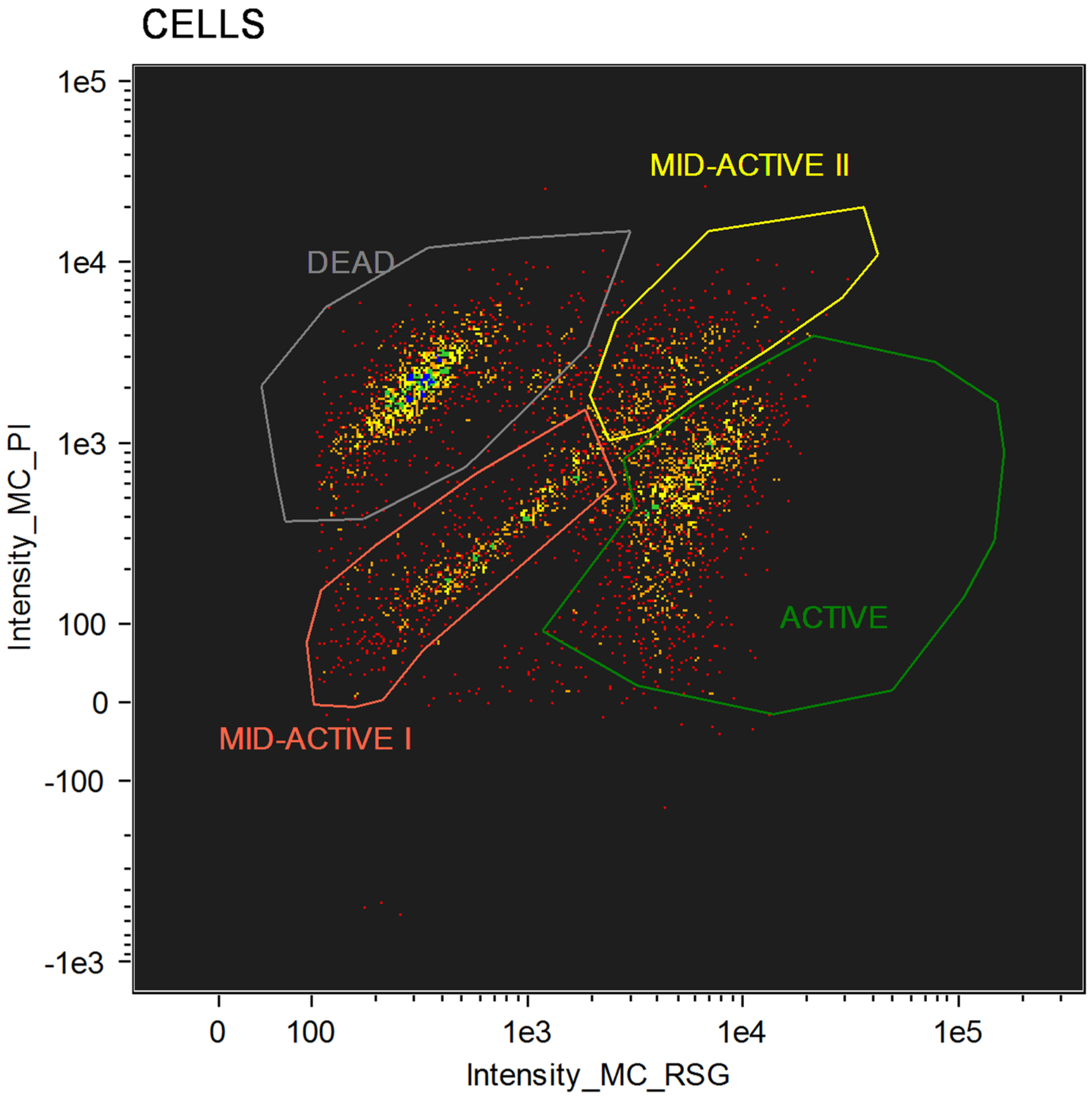
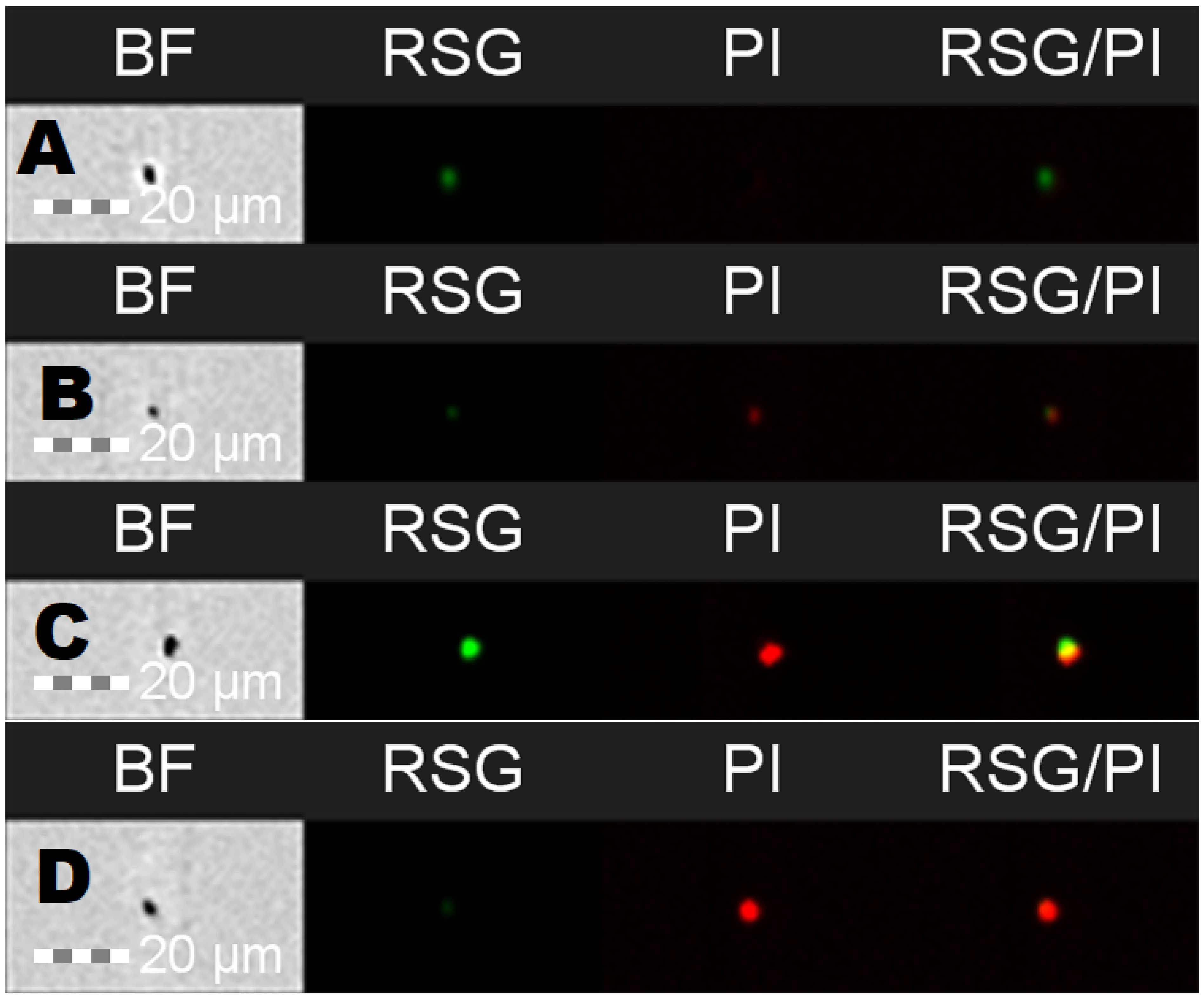
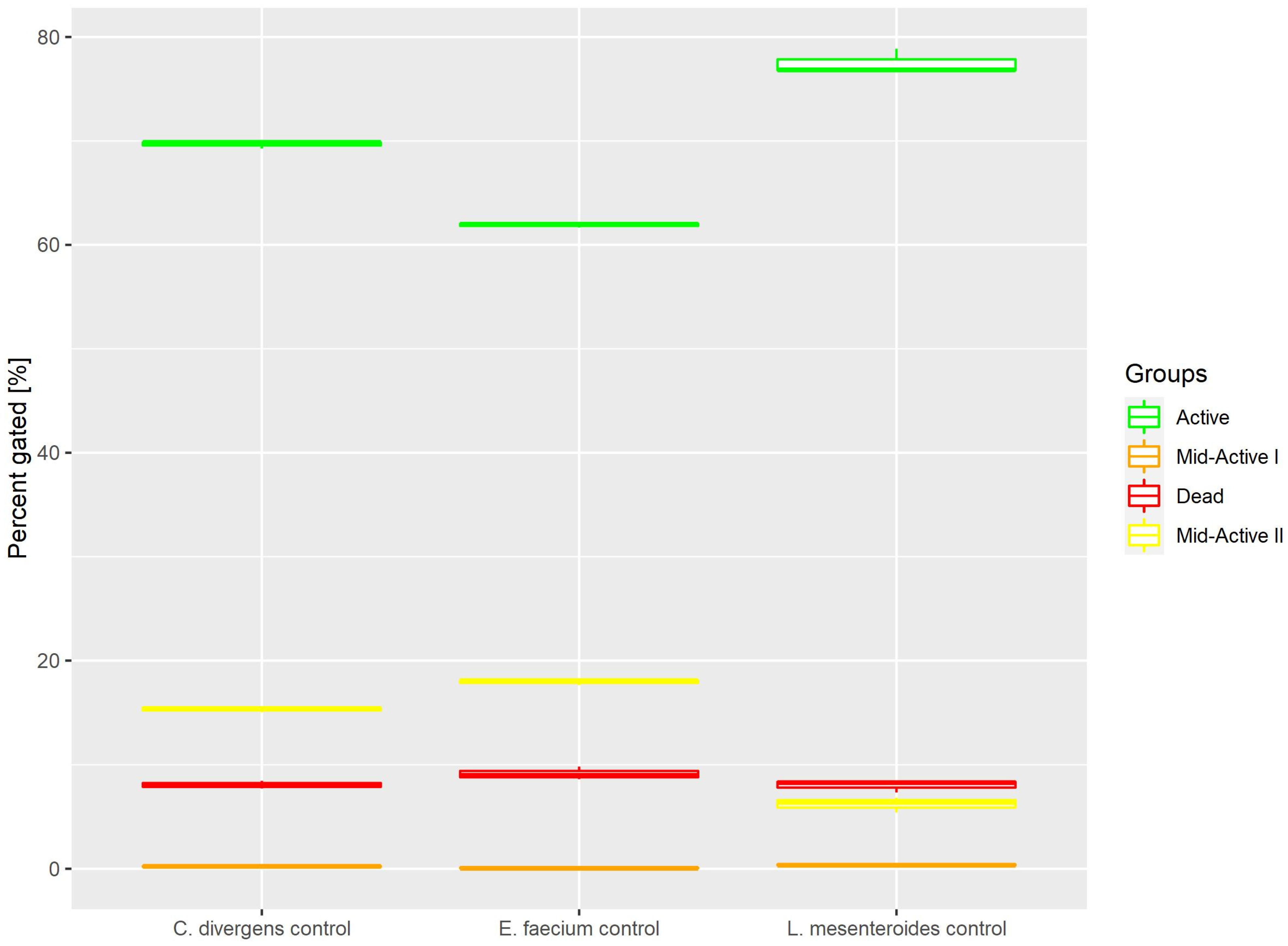
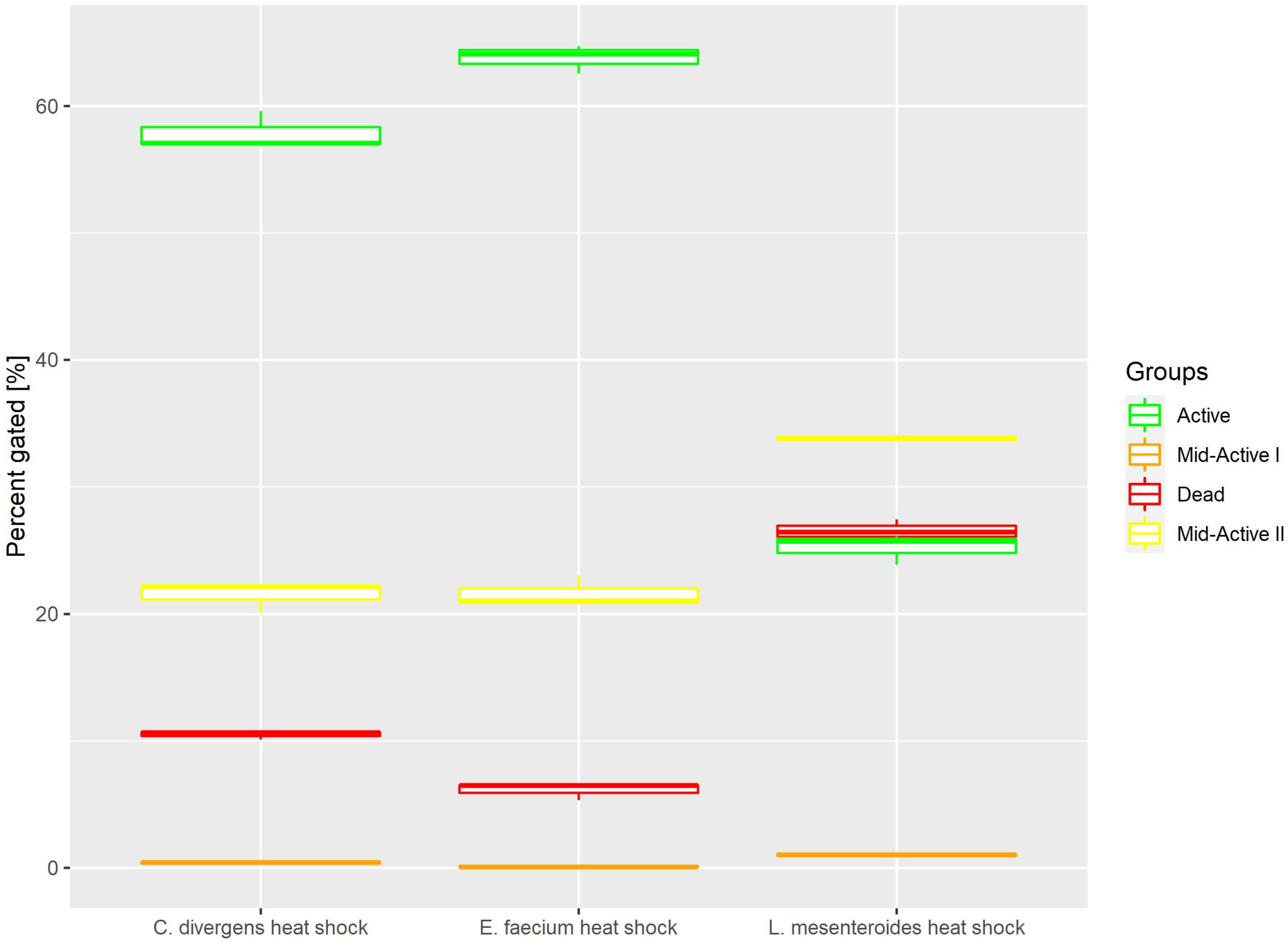
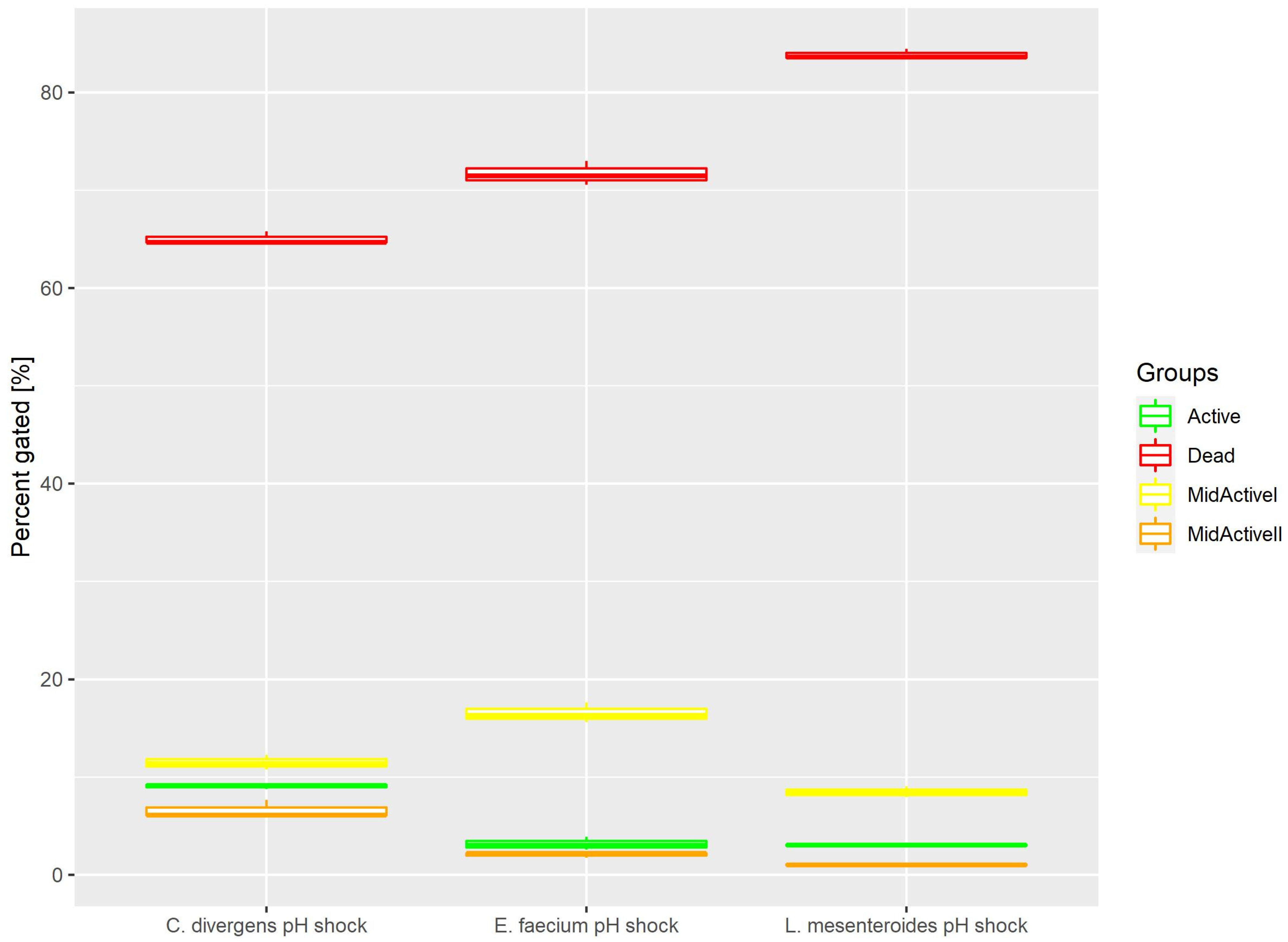
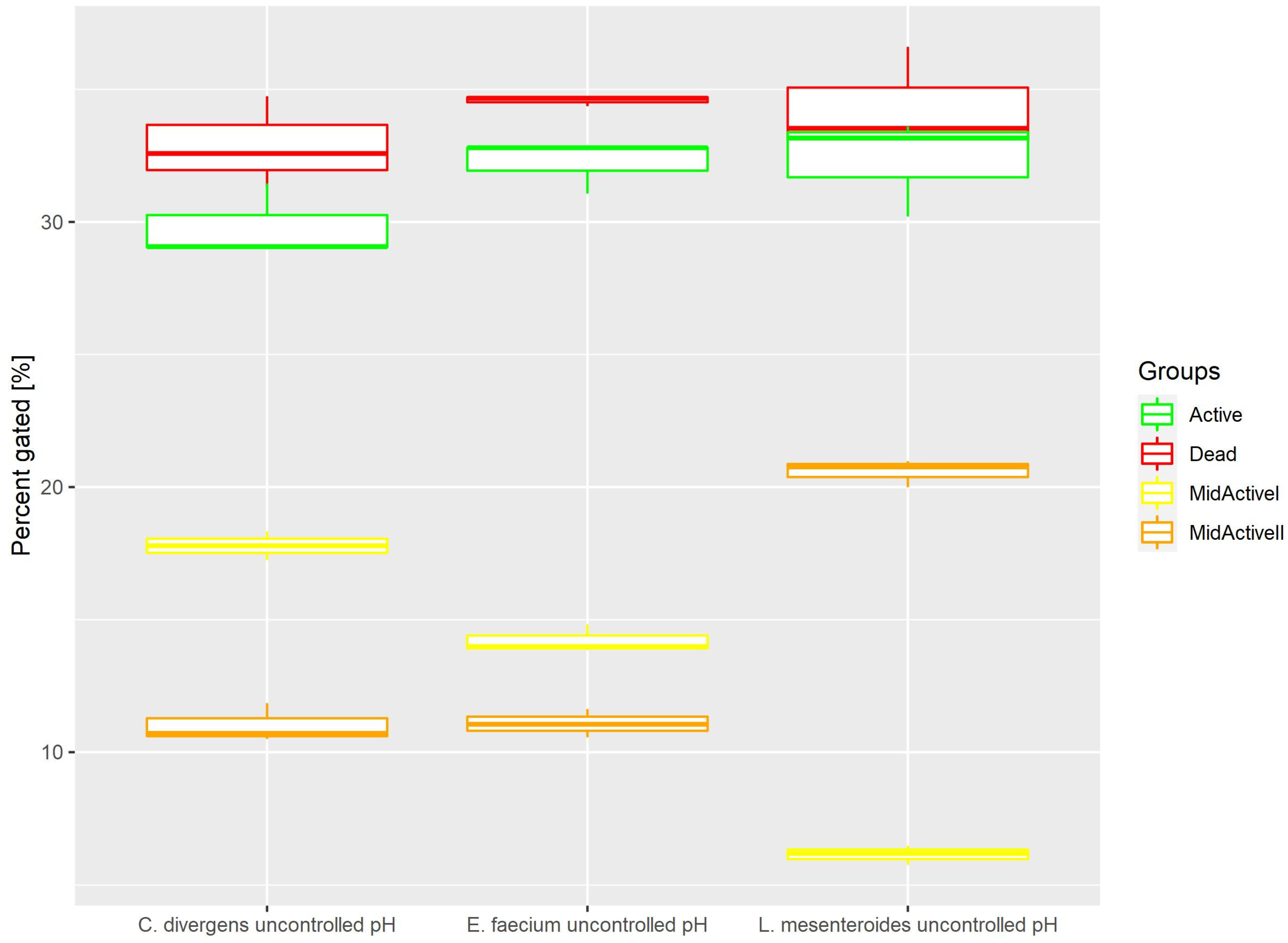


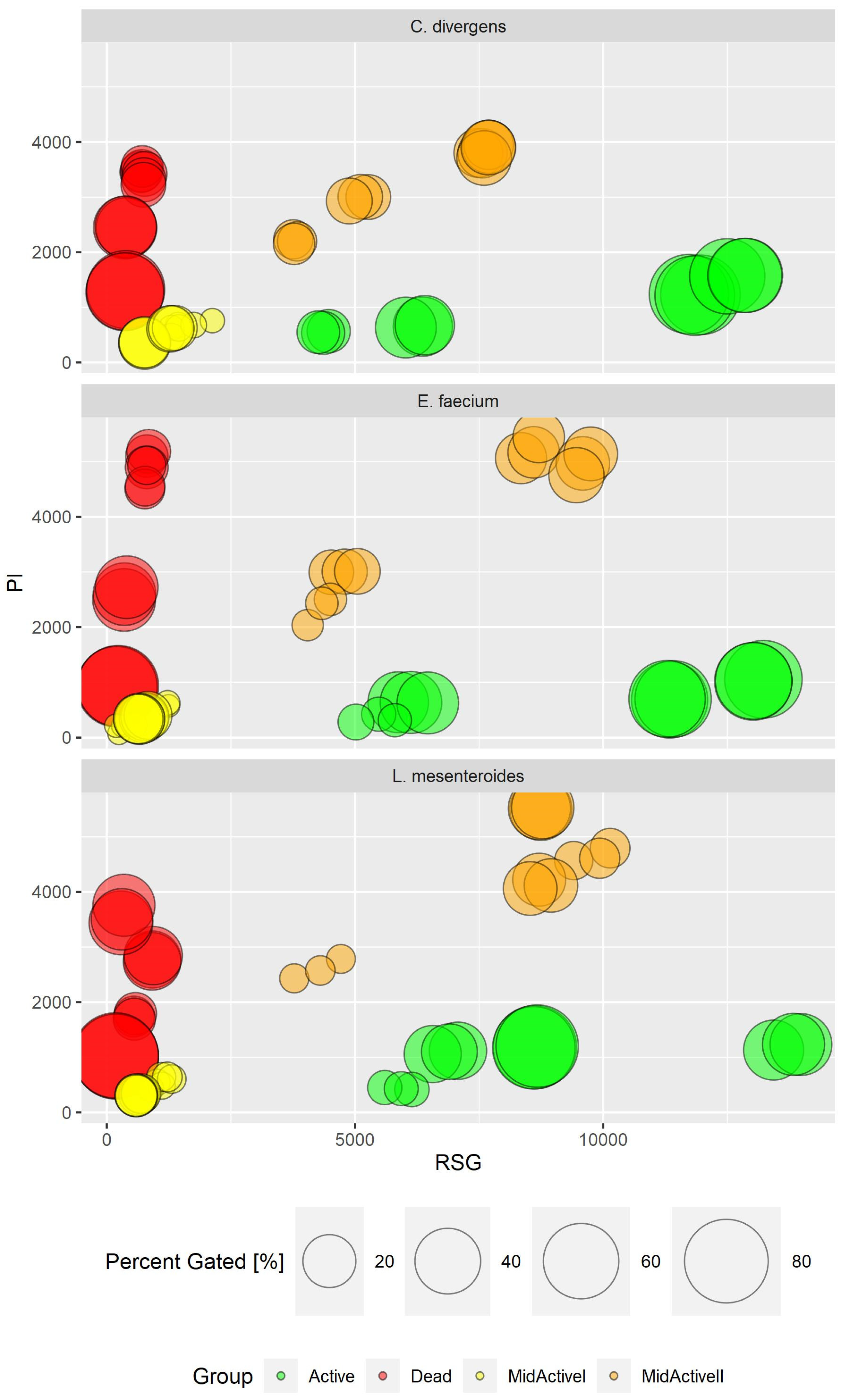
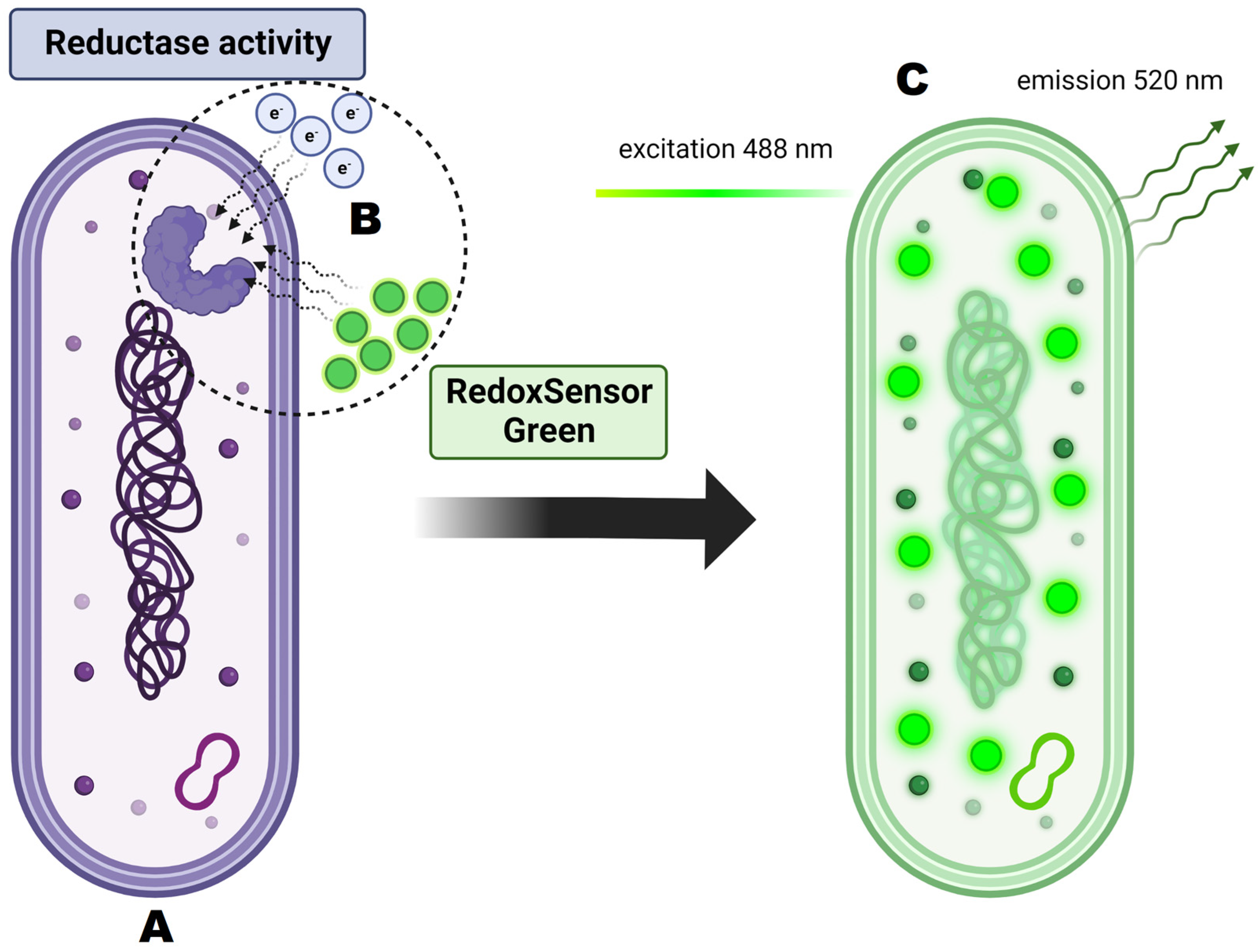
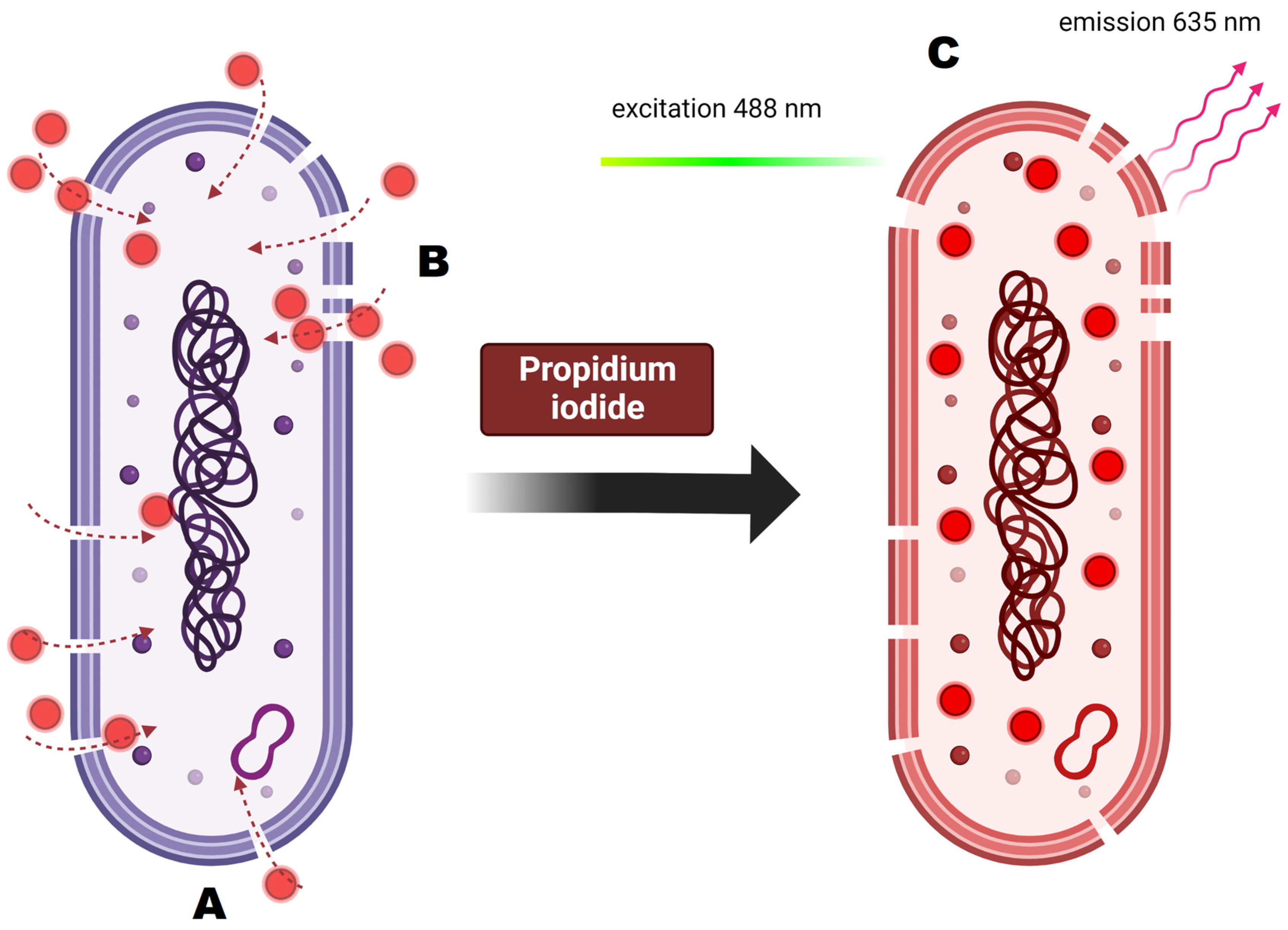
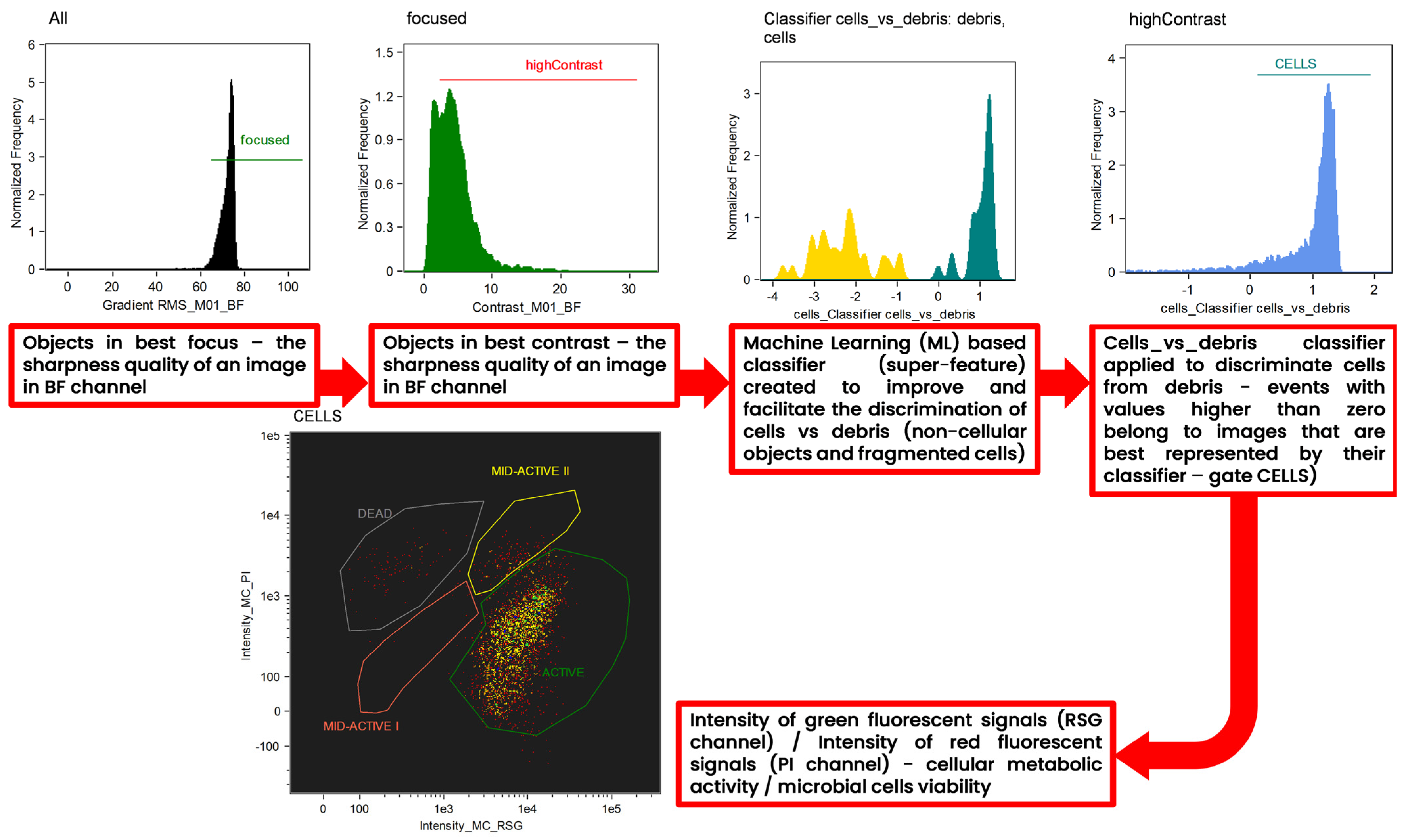
| Sample Name | Plate Cell Counts [cfu/mL] | Flow Cytometry [obj/mL] | ||||
|---|---|---|---|---|---|---|
| Total | Dead | Mid-Active I | Mid-Active II | Active | ||
| L. mesenteroides | 2.7 × 108 | 3.57 × 108 | 2.16 × 107 | 1.05 × 106 | 1.68 × 107 | 2.10 × 108 |
| L. mesenteroides heat shock | 1.29 × 108 | 1.85 × 108 | 3.52 × 107 | 1.36 × 106 | 4.50 × 107 | 3.35 × 107 |
| E. faecium | 4.05 × 108 | 2.72 × 108 | 2.17 × 107 | 2.02 × 105 | 4.26 × 107 | 1.47 × 108 |
| E. faecium heat shock | 5.85 × 108 | 2.53 × 108 | 1.32 × 107 | 2.04 × 105 | 4.65 × 107 | 1.37 × 108 |
| C. divergens | 4.05 × 108 | 3.40 × 108 | 2.13 × 107 | 5.68 × 105 | 4.05 × 107 | 1.84 × 108 |
| C. divergens heat shock | 9.35 × 107 | 2.50 × 108 | 2.13 × 107 | 8.37 × 105 | 4.36 × 107 | 1.18 × 108 |
| Sample Name | MRS-Agar on Petri Dishes [cfu] | MRS Broth on 96-Well Plates [OD600 > 0.1] | ||||||
|---|---|---|---|---|---|---|---|---|
| Active | Mid-Active I | Mid-Active II | Dead | Active | Mid-Active I | Mid-Active II | Dead | |
| E. faecium dried 48 h/72 h | 20.8%/37.5% | 0%/0% | 8.3%/8.3% | 0%/0% | 75%/83.3% | 0%/0% | 8.3%/16.7% | 0%/0% |
| E. faecium coated 48 h/72 h | 20.8%/29.2% | 0%/0% | 25%/29.2% | 0%/0% | 20.8%/29.2% | 0%/0% | 12.5%/12.5% | 0%/0% |
| L. mesenteroides dried 48 h/72 h | 4.2%/8.3% | 0%/0% | 8.3%/8.3% | 0%/0% | 4.2%/8.3% | 0%/0% | 0%/0% | 0%/0% |
| L. mesenteroides coated 48 h/72 h | 20.8%/33.3% | 0%/0% | 4.2%/12.5% | 0%/0% | 8.3%/20.8% | 4.2%/12.5% | 4.2%/4.2% | 0%/4.2% |
| Parameters | Weights |
|---|---|
| H Entropy Std_M09_Ch09_9 | −18.39 |
| H Entropy Std_M01_BF_9 | −17.57 |
| H Homogeneity Std_M01_BF_11 | −12.9 |
| Area_MC | −12.89 |
| H Entropy Std_M01_BF_11 | −12.88 |
| H Entropy Mean_M09_Ch09_9 | −12.69 |
| Major Axis Intensity_M09_Ch09 | −12.68 |
Disclaimer/Publisher’s Note: The statements, opinions and data contained in all publications are solely those of the individual author(s) and contributor(s) and not of MDPI and/or the editor(s). MDPI and/or the editor(s) disclaim responsibility for any injury to people or property resulting from any ideas, methods, instructions or products referred to in the content. |
© 2023 by the authors. Licensee MDPI, Basel, Switzerland. This article is an open access article distributed under the terms and conditions of the Creative Commons Attribution (CC BY) license (https://creativecommons.org/licenses/by/4.0/).
Share and Cite
Kiepś, J.; Juzwa, W.; Dembczyński, R. Imaging Flow Cytometry Demonstrates Physiological and Morphological Diversity within Treated Probiotic Bacteria Groups. Int. J. Mol. Sci. 2023, 24, 6841. https://doi.org/10.3390/ijms24076841
Kiepś J, Juzwa W, Dembczyński R. Imaging Flow Cytometry Demonstrates Physiological and Morphological Diversity within Treated Probiotic Bacteria Groups. International Journal of Molecular Sciences. 2023; 24(7):6841. https://doi.org/10.3390/ijms24076841
Chicago/Turabian StyleKiepś, Jakub, Wojciech Juzwa, and Radosław Dembczyński. 2023. "Imaging Flow Cytometry Demonstrates Physiological and Morphological Diversity within Treated Probiotic Bacteria Groups" International Journal of Molecular Sciences 24, no. 7: 6841. https://doi.org/10.3390/ijms24076841
APA StyleKiepś, J., Juzwa, W., & Dembczyński, R. (2023). Imaging Flow Cytometry Demonstrates Physiological and Morphological Diversity within Treated Probiotic Bacteria Groups. International Journal of Molecular Sciences, 24(7), 6841. https://doi.org/10.3390/ijms24076841






